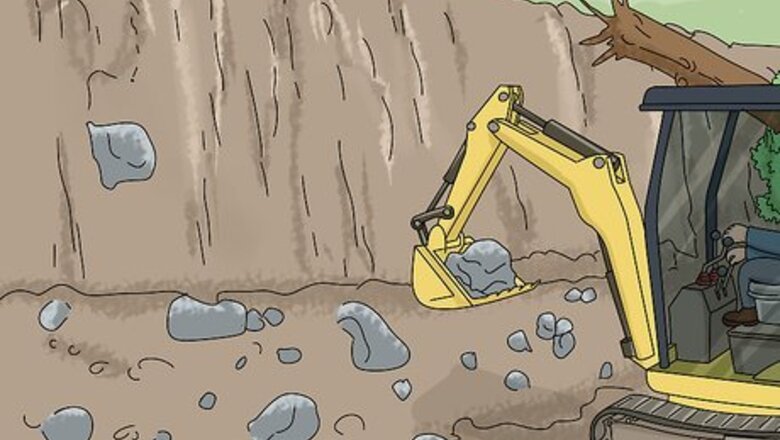
views
Limiting Property Damage Risks

Remove loose or heavy material from the top of the slope. Rocks, fallen trees, and other debris at the top of a hill can put your property at risk for a landslide. Clean off all the slopes on your property to remove material that might come loose. Move this debris away from the slope, on the base, or off your property altogether. You might need a professional with heavy equipment to remove heavy rocks and soil. Consult a contractor on hauling away heavy material like this. Be courteous to your neighbors when you relocate this material. Don't put them in a place where they could slide onto your neighbors' property.
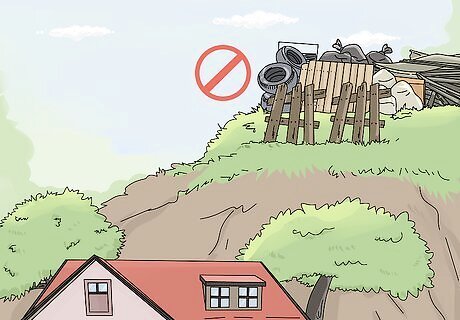
Avoid piling junk at the top of a hill. If your property sits on the edge of a hill, keep all loose debris away from that slope. These can come loose and slide down the hill. Whether you have scrap wood, lawn cuttings, or spare parts, pile all debris at least 10 feet (3.0 m) away from the edge. Keep any loose material like firewood or trash cans away from the slope as well. Don’t dump water at the top of the slope either. This can gradually erode the soil and make it looser.
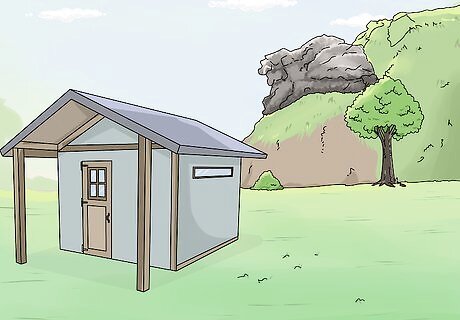
Build sheds or other structures away from an edge. If you’re planning a new shed or similar structure, keep it far away from the edge of a slope. Consult an engineer to tell you what a safe distance from the slope is and follow that advice before you start building. There isn’t a hard rule on how far structures should be from the slope. It depends on the soil, drainage, slope, and how prone the area is to landslides.
Controlling the Water on Your Property
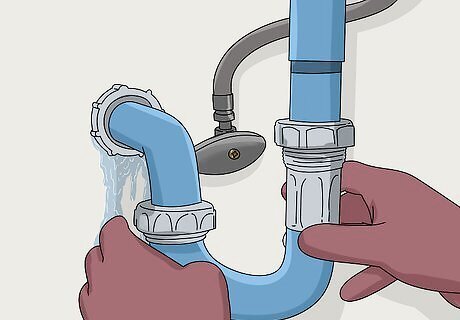
Fix any leaks in your pipes or drainage system. Leaks in your water system can gradually erode the soil under your property. Have a professional go through your pipes and make sure there are no leaks. If they do locate leaks, fix them right away. There are a few signs that you might have a water leak. These include an unusually high water bill, a musty smell in some areas of your home, or puddles on your property when it hasn’t rained recently. Remember to check your outdoor water lines as well, like your hose, pool, and sprinkler system if you have one. Leaky pools are a particular cause of gradual soil erosion.
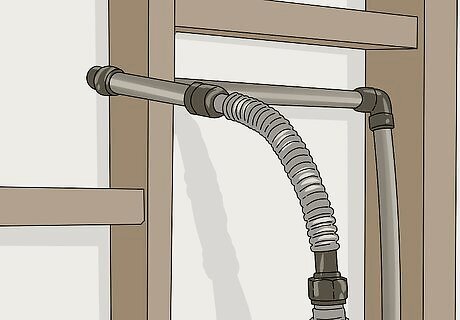
Install flexible fittings to prevent your pipes from breaking. Flexible fittings won’t crack, which helps prevent water leaks. Use these fittings at turns and angles in your pipe system so your water lines are more resilient. Installing flexible fittings is similar to installing regular pipes. You can do it yourself if you feel confident, or have a plumber do the job. Flexible fittings are especially useful in areas prone to landslides because they’ll resist breaking if there’s a shift in the ground. You can use flexible fittings in your gas lines as well. This is a dangerous job that could cause a gas leak if it's done incorrectly, so don’t do it yourself. In some areas it's even illegal to work on gas lines by without a license. Have someone who works for your gas provider make this adjustment.
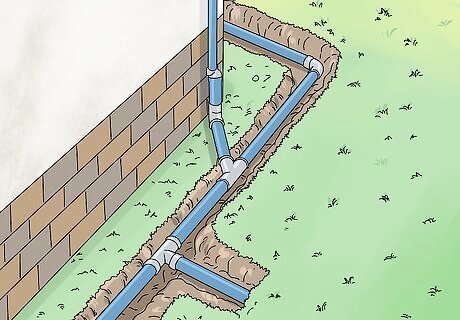
Make sure your drainage system leads directly to the base of the incline. If you have a downspout or similar drainage system to carry water away from your home, make sure it runs all the way to the bottom of the slope. This stops the water from pooling or running down the slope and loosening the ground. You might not be able to drain the water all the way to the bottom if the base is further than your property goes. Instead, make sure your system flows into the nearest storm drain or a natural runoff area. Make sure the water drains far away from your neighbors as well. You wouldn't want them draining their water onto your property.
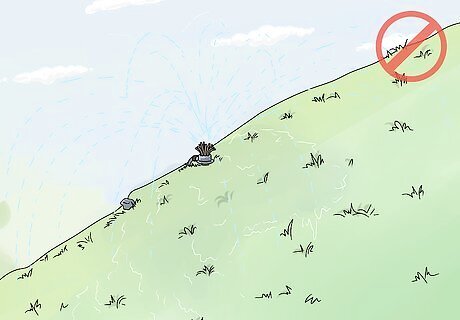
Avoid building sprinkler systems on a slope. These can loosen and erode soil, making the slope more unstable. Always locate your sprinkler system a safe distance from the slope so the land remains stable. If a professional engineer installs your irrigation system, they should know what a safe distance away from the slope would be. If you do it yourself, check any local codes that state how far the irrigation system must be from a slope.
Strengthening the Ground

Remove loose soil and replace it with more dense material. Over time, soil can erode and grow more prone to landslides. Speak with a contractor about replacing your topsoil with denser, sandy soil that’s more tightly-packed. This can help make the land on your property more stable. This is a professional job that requires machinery and equipment. Don’t try to do it on your own. Do not push any old material back up the slope or towards the edge. This increases the landslide risk. Take other measures to protect the soil besides replacement. Over time, the new soil will erode as well and become landslide-prone without other steps.

Build a retaining wall at the base of a slope to protect your home. If you live in a landslide-prone area or at the base of a hill, then this is your best chance for protection. Extend the wall for the entire length of your property for the best protection. A reinforced retaining wall with metal spikes drilled into the ground rock is the best method to guard against landslides. The footing should be behind the wall and as wide as the height of the wall. This can prevent landslides or divert the flow away from your home. If you build a wall, putting drainage behind the wall is extremely important. This will prevent the wall from tipping over and sliding down the hill if any pressure buildup or water accumulates in front of it.
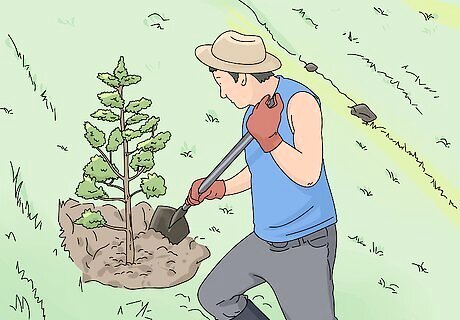
Plant trees and shrubs on hills to keep the soil packed and protected. Vegetation protects the soil from erosion and prevents landslides. If the slopes on your property are bare, try planting some plants with thick or deep root systems. Good choices are trees, shrubs, and tall grasses. If the slope already has plants on it, do your best to protect. Don’t cut down trees or pull up shrubs without replacing them. If you have to remove some vegetation because you did landscaping work, then get new plants as soon as possible to prevent erosion. If the slope is on your neighbor’s property, talk with them to see if they’ll grow some plants on it. Offer to help pay for it to convince them.
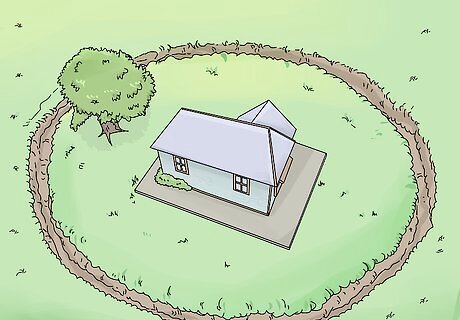
Dig a ditch to divert landslides away from your home. Even with other preventative measures, landslides can still happen. In this case, you can still protect your home with a ditch surrounding your property. This can capture or divert the debris to another location, protecting your home. Consult a contractor for this job. It requires a lot of technical knowledge and equipment to build a proper ditch. Make sure the debris is redirected to a vacant area. If your ditch redirects debris to flow onto a neighbor’s property, you could be liable for damages.




















Comments
0 comment